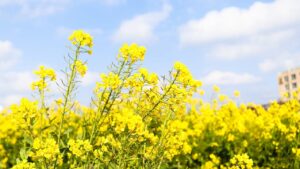There are precious resources contained in Canadian canola seed and now growers have an innovative tool to better protect them.
These resources are the genes that provide canola plants with resistance against blackleg. In the past, growers managed blackleg (there are at least eight different blackleg strains in Western Canada) by planting a canola variety different from the one they had planted on the same field, usually two or three years before. In short, growers had to rely on luck that the new variety would contain different resistance genes than the variety planted previously, explains Shaan Tsai, product development manager for oilseeds and pulses at Canterra Seeds.

“Growers never quite knew exactly what type of resistance they had in the variety they were using,” he says. “They had to go with a general field rating that was based on specific locations at the time of registration testing, a rating that in many cases represented resistance to races of the disease that are vastly different than what farmers could expect in their own fields.”
Tsai says this has ultimately led to many a farmer experiencing disappointing yield losses due to blackleg, and points to a recent study by Agriculture and Agri-food Canada scientists that found even low levels of infection could lead to yield losses of up to 20 per cent.
Ralph Lange, team leader of crop pathology and molecular biology at InnoTech Alberta, echoes the sentiment. “We used to tell people to just plant another variety on the chance that it would have different resistance genes,” he says. Therefore, in many cases the blackleg fungus has been presented with canola varieties with resistance genes it could overcome, and in recent years, some growers have noticed increased blackleg severity in their ‘R’ and ‘MR’ varieties.
To steer this situation in a new direction, the Canola Council of Canada (CCC), the Blackleg Steering Committee, and the Western Canadian Canola/Rapeseed Recommending Committee are implementing a much more specific rating system, an idea first developed in Australia. In short, instead of guessing, growers will be able to determine over time which genes are not working against whatever blackleg strain they’ve got, and can switch to a variety with a different resistance gene(s) — thereby gaining a much better chance of improved crop performance against the pathogen.

“These new resistance labels will be important for producers who have been noticing increasing blackleg issues in their fields,” notes Canola Council agronomy director Clint Jurke. “If producers have not had any issues with blackleg, then they can keep doing what they are doing. This is for those that are experiencing higher levels of disease than they would like to have.” As many as 10 new blackleg resistance labels will be applied to various ‘R’ and ‘MR’ canola varieties in the coming years, with the letters A, B, C, D, E1, E2, F, G, H and X used to identify major resistance genes present (see sidebar for variety examples).
Tsai notes that while these labels will improve a grower’s odds at zeroing in on their races and keeping the disease in check, he adds “from what I understand, we are getting very close in the development of a quick test to better characterize the blackleg races in a field and it will likely not be long before a grower can submit a sample to their local diagnostic lab, get a full profile of the blackleg pathogens in their field, and make their variety selections accordingly. In the meantime, there are ‘multigenic’ varieties available with several types of major genes in a single variety that can offer a broad defence against the disease.”
Jurke notes that ‘multigenic’ is a term used differently by various parties (e.g. to refer to quantitative resistance, stacks of R genes, or a stack of R genes with quantitative resistance) but that industry consensus is expected soon.
Records Critical
Frequent and accurate scouting with excellent record keeping is essential for determining if the genes in a given variety are, or are not, working against the blackleg on a particular farm. If the variety a grower planted two or three years ago is still around and isn’t sporting one of the new labels for 2018 and the grower would like to know which resistance genes it contains, Lange notes that they could call the seed company and ask. He’s not sure if the company would be able to tell growers that information, but it would make records from years past more meaningful and enable growers to more quickly put improved management in place.
As to whether listing of resistance genes will be applied for other crops and diseases in future besides blackleg in canola and Phytophthora root rot in soybeans, Tsai, Jurke and Lange all believe it will depend on the crop and the disease. “We know certain export markets are more sensitive than others for certain diseases,” says Tsai, “and these types of labelling systems and initiatives not only help the grower level tackle important agronomic management issues but also have the broader effect of strengthening the international competitiveness of the Canadian crop as a whole.”
In the end, to make this system work, Lange urges growers to keep excellent records, make sure their scouting is as accurate as possible and to do a thorough job in tracking variety performance. “Unless you have good records, this new system won’t help you,” he says. “It’s a new skill set for growers or agronomists to be able to use this type of knowledge, and this will likely become more and more important.”
The CCC reminds growers that the use of blackleg gene labels is presently a voluntarily process for seed companies to include on their varieties, and that it will take some time for a full rollout.










